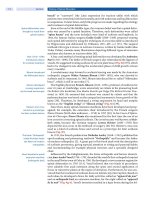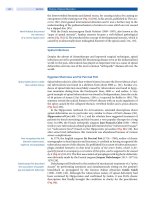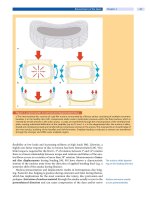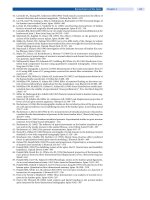Spinal Disorders: Fundamentals of Diagnosis and Treatment Part 13 pdf
Bạn đang xem bản rút gọn của tài liệu. Xem và tải ngay bản đầy đủ của tài liệu tại đây (525.61 KB, 10 trang )
The Intervertebral Disc and Cartilage Endplate
The intervertebral discs are located between the vertebral bodies. They transmit
load arising from body weight and muscle activity through the spinal column
and also provide flexibility to the spine by allowing bending, flexion and torsion.
The discs of the lumbar spine are approximately 7–10 mm thick and 40 mm in
diameter (anterior-posterior), representing one-third of the height of the spine
[120, 141]. Generally, the discs consist of three highly specialized structures: the
Thediscconsistsofthree
highly specialized structures
anulus fibrosus, the nucleus pulposus and the cartilage endplate that forms the
interface with the adjacent vertebral bodies.
Inter vertebral Disc
The intervertebral disc
undergoes dramatic alter-
ations with aging
Among all the tissue components of the spine, the intervertebral discs exhibit the
most striking alterations with age. Because of these dramatic changes, many
spinespecialistsbelievethatthediscisamajor source of back and neck pain.The
intervertebral disc has attracted much research to unravel the underlying molec-
ular mechanism of disc degeneration. Although the intervertebral disc is much
better explored than other components of the spine, our understanding of its
molecular biology is still in its infancy.
Normal Anatomy and Biochemical Composition
The outer anulus fibrosus
consists of concentric rings
of collagen fibers
Theanulusfibrosusismadeupof15–25concentricringsconsistingofparallel
collagen fibers. These rings are termed lamellae and are visible macroscopically
in healthy discs. The collagen fibers in each lamella are oriented at approximately
60° to the vertical axis, alternating left and right to the adjacent lamellae (see
Chapter
2 ). Elastin fibers intersperse the lamellae and may play an important
role in restoration of shape after bending of the spine [161]. The cellular part of
theanulusfibrosusconsistsofthinandelongatedfibroblast-like cells aligned to
the collagen fibers (
Fig. 2) [114, 117].
The nucleus is the gelatinous
core of the disc and is rich in
proteoglycan
Surroundedbytheanulusfibrosusisthenucleuspulposus,thegelatinous core
of the intervertebral disc. The matrix of the nucleus pulposus consists of ran-
domly organized collagen fibers and radially arranged elastin fibers that are
embedded in a highly hydrated aggrecan-containing proteoglycan gel. Inter-
spersed ata low density are rounded chondrocyte-like cells usually located inside
a capsule in the surrounding matrix (so-called lacunae) [82].
Macroscopically, the boundary between the anulus fibrosus and the gelatinous
nucleus pulposus can only be distinguished in young individuals (
Fig. 2). The dif-
ferent mechanical properties of anulus fibrosus and nucleus pulposus are deter-
mined by composition and organization of the respective extracellular matrix.
Although the mechanical properties of nucleus pulposus and anulus fibrosus are
very different, the main components are very similar and consist of:
water
proteoglycans
collagen
Wate r makes up 80% of the wet weight of the nucleus and 70% of the wet weight
of the anulus [105, 162]. Collagen and proteoglycans fulfil complementary func-
tions in the tissue.
Age-Related Changes of the Spine Chapter 4 95
a
b
Figure 2. Normal anatomy and composition
a Mid-sagittal section through a healthy young
intervertebral disc. The white cartilage endplates,
the gel-like nucleus pulposus and the surrounding
anulus fibrosus can easily be distinguished. Large
arrows show the direction of axial load on the disc.
Small arrows indicate dissipation of the compressive
forces to the anulus fibrosus.
b Upper panels: sche-
matic presentation of the composition of nucleus
pulposus (NP) and anulus fibrosus (AF)(AG aggre-
can, HA hyaluronan, CII collagen type II fibers, CI col-
lagen type I fibers). Lower panels: histological view
of the chondrocyte-like cells of the NP and the fibro-
blast-like cells of the AF (schematic representation
of the NP matrix adapted from [121]).
Collagens
are mechanically stable proteins
provide tensile strength
are mainly collagen types I and II
Proteoglycans
consist of chondroitin and negatively charged keratan sulfate chains
are osmotically active due to their negative charge
maintain hydration of the tissue through osmotic pressure
96 Section Basic Science
To meet the different mechanical needs of anulus fibrosus and nucleus pulposus,
the compositions of the respective extracellular matrices vary substantially. The
The anulus resists high
tensile forces
anulus fibrosus that is responsible for containing the nucleus pulposus and with-
standing the resulting tensile forces consists of up to 70% (percent dry weight) of
collagentypeIandIIwhereasthenucleuspulposusonlycontains20%ofcolla-
gen [31]. On the other hand, the nucleus pulposus that is responsible for dissipat-
ing the compressive forces on the disc by exerting a hydrostatic pressure on the
anulus fibrosus consists of up to 50% of proteoglycans (percent wet weight),
whereas the anulus fibrosus only contains 20% proteoglycans (
Fig. 2b). These
differences in proteoglycan content are also reflected by the water content of the
two tissues (80% in the nucleus pulposus and 70% in the anulus fibrosus).
The collagen and
proteoglycan interplay
influences disc functions
Besides these main components, there are several minor components
including collagen III, V, VI, IX, X, XI, XII and XIV [5, 10, 29, 31, 38, 43, 113] and
also small proteoglycans such as lumican, biglycan, decorin and fibromodulin
and other non-collagenous proteins like fibronectin (
Table 1
). The exact role
of these additional matrix proteins and glycoproteins is not completely clear
[55, 87].
In the normal disc, matrix
degradation and synthesis
are in balance
It is important to keep in mind that the disc matrix is not a static but a dynamic
structure. The components of the matrix are continuously degraded and
replaced by newly synthesized molecules. Degradation of matrix components is
Table 1. Biochemical disc components
Matrix molecule
Tissue distribution
and abundance
Function References
Collagens
Type I
Type II
dominant component: 70 % of the dry weight of
theanulus,20%ofthedryweightofthe
nucleus
[5, 31]
[6, 31]
collagen I: major component of anulus fibrosus tensile strength
collagen II: major component of nucleus pulposus
and cartilage endplate
anchors tissue to bone
Type III minor component of anulus fibrosus mechanical function [126]
Type V minor component of anulus fibrosus mechanical function [126]
Type VI minor component of anulus fibrosus and cartilage
endplate
mechanical function [126]
Type IX minor component of nucleus pulposus and
cartilage endplate
mechanical function: forms
crosslinks between
collagen fibrils
[126]
Type X minor component of hypertrophic cartilage
endplate
mechanical function [126]
Type XI minor component of the nucleus pulposus mechanical function [126]
Type XII minor component mechanical function [126]
Type XIV minor component mechanical function [126]
Proteoglycans
Large
Aggrecan all proteoglycans make 50 % of the wet weight of
the nucleus and 20% of the anulus
tissue hydration (water
retention)
[25, 135]
Versican [25]
Small
Biglycan tissue hydration [25, 55, 62, 87, 122]
elevated in deg. disc regulate formation of matrix
Decorin mechanical function [87, 122]
regulate formation of matrix
Fibromodulin [87, 134]
Lumican [8, 134]
non-collagenous proteins
Fibronectin minor component role unclear [41, 97]
Elastin minor component (2 %) mechanical function [8]
Chondronectin minor component role unclear [57, 76, 81, 127, 157]
Age-Related Changes of the Spine Chapter 4 97
an enzymatic process catalyzed by matrix metalloproteinases (MMPs) and
aggrecanases that are synthesized by disc cells [27, 118]. The balance between
synthesis, degradation and accumulation of matrix molecules determines the
quality and integrity of the disc matrix and is also prerequisite for adaptation/
alteration of the matrix properties to changing environmental conditions.
Nutritional supply and
waste removal entirely
depend on diffusion
The majority of a healthy adult disc is avascular. The blood vessels closest to
thediscmatrixarethereforethecapillarybedsoftheadjacentvertebralbodies
and small capillaries in the outermost part of the anulus fibrosus [24, 46]. The
blood vessels present in the longitudinal ligaments running adjacent to the disc
and in young cartilage endplates (less than 12 months old) are branches of the
spinal artery [49, 50, 142]. As a consequence of the avascularity, the nutrient sup-
ply to the disc cells and removal of metabolic waste products is entirely depen-
dent on diffusion mainly from or to the capillary beds of the adjacent vertebrae
[49]. Animal experiments indicated that the role of the peripheral small capillar-
ies for the nutrient supply is only of minor importance [102]. The dependency of
nutrient supply to the inner parts of the disc on diffusion together with the poor
diffusion capacity of the disc matrix severely limits nutrient and waste exchange.
As a result, a gradient between the inner parts and the peripheral regions of the
disc builds up with very low levels of glucose and oxygen and high levels of the
waste product lactic acid on the inside [49] (
Fig. 3). These gradients are even fur-
ther aggravated by the disc cells using oxygen and glucose and producing lactic
acid [49, 56]. The restricted nutrient supply and the increasing acidic milieu,due
to the accumulation of lactic acid, are considered the main factors limiting cell
viability and therefore the integrity of the disc matrix.
Macroscopic Disc Alterations
Onset and progression of age-related alterations of the disc can be determined
with various techniques. MRI allows disc degeneration to be studied in vivo.
Applying this technique revealed that early signs of age-related alterations could
Figure 3. Disc nutrition
Glucose and oxygen concentration were found to drop steeply from the endplate towards the inner part of the nucleus
pulposus (glc glucose, O
2
oxygen). Lactate concentration displayed the opposite course, with highest levels in the inner
region (lac lactate). This profile reflects the nutrient limitations in the inner disc and the lower pH values on the inside due
to the acidic waste product lactate. The sagittal section through an intervertebral disc shows the region of the deter-
mined concentrations (adapted from [143]).
98 Section Basic Science
Figure 4. Macroscopic age-related disc changes
Grade I: normal juvenile disc
nucleus pulposus and anulus fibrosus can clearly be distinguished
the nucleus pulposus has a gel-like appearance and is highly
hydrated
anulus fibrosus consists of discrete fibrous lamellae
cartilage endplates are uniformly thick and consist of hyaline cartilage
Grade II: normal adult disc
peripheral appearance of white, fibrous tissue in the nucleus pulpo-
sus
mucinous material is found between the lamellae of the anulus
fibrosus
thickness of the cartilage endplate is irregular
Grade III: early stage
consolidated fibrous tissue in the whole nucleus pulposus
demarcation between nucleus pulposus and anulus fibrosus is lost
and extensive mucinous infiltration in the anulus fibrosus is
observed
cartilage endplates show focal defects
Grade IV: advanced stage
clefts in the nucleus pulposus appear, usually parallel to the end-
plate
focal disruptions are found in the anulus fibrosus
hyaline cartilage of the endplate is replaced by fibrocartilage; irregu-
larities and focal sclerosis are found in the subchondral bone
Grade V: end stage
typical disc structure may be lost completely
clefts extend through nucleus pulposus and anulus fibrosus
endplates display diffuse sclerosis
The different stages represent age-related changes which occur dur-
ing life (modified from [138]).
Disc degeneration starts as
early as the second decade
of life
already be observed in the second decade of life [47]. However, more detailed
information has been gained from macroscopic postmortem analysis of interver-
tebral disc tissue from individuals of various ages [92]. These studies have led to
grading systems that on one hand allow the evaluation of stages of disc degenera-
tion, but also illustrate the process of age-related degeneration. The original
grading system was established by Friberg and Hirsch (and propagated by Nach-
emson) and has been further refined by Thompson et al. [34, 95, 138]. Thomp-
son’s grading system distinguishes five stages that describe age-related degener-
ation from healthy young discs leading to old heavily degenerated intervertebral
disc (
Fig. 4) [138]:
Microscopic Alterations of the Disc During Aging
To improve the rather poor resolution of macroscopic approaches to analyzing
disc degeneration, Boos et al. established a histological degeneration score
(HDS) [17]. Studying age-related changes at the microscopic level, several hall-
Age-Related Changes of the Spine Chapter 4 99
abc
de
fgh
Figure 5. Microscopic
age-related disc changes
Histologic routine stainings repre-
senting age-related alterations of the
intervertebral disc (
a–e)andthecarti-
lage endplate (
f–j). Upper picture
shows slight degenerative change of
the respective feature, the lower pic-
ture severe alterations (
a–h). a Chond-
rocyte proliferation;
b mucous degen-
eration;
c cell death; d tear and cleft
formation;
e granular changes; f cell
proliferation;
g cartilage disorganiza-
tion;
h presence of cartilage cracks;
100 Section Basic Science
i
j
Figure 5. (Cont.)
i formation of new bone; j bony
sclerosis (according to Boos et al.
[17]).
marks for degenerative changes were identified for the intervertebral disc and
the cartilage endplates (
Fig. 5).
Intervertebral Disc
chondrocyte proliferation (increasing cell clusters due to reactive prolifera-
tion)
mucous degeneration (accumulation of mucous substances)
cell death
tear and cleft formation
granular changes: increasing accumulation of granular tissue
Cartilage Endplate
cell proliferation
cartilage disorganization
presence of cracks in the cartilage
presence of microfractures
formation of new bone
bony sclerosis
Chondrocyte proliferation
is the first sign of disc
degeneration
First signs of tissue degradation are seen between 10 and 16 years of age when
tearsinthenucleuspulposusoccuralongwithfocaldisc cell proliferation and
granular matrix transformation [17]. In parallel, the amount and extent of acidic
mucopolysaccharides in the matrix increase. The general structure of the nucleus
pulposus and the anulus fibrosus, however, is preserved in this age group.
In the young adult disc (up to approx. 30 years of age), the aforementioned
changes of the nucleus pulposus are observed to a considerable extent. The
nucleusisaccordinglytransformedbymultiple large clefts and tears and the
matrix shows significant granular changes. In this age group the first histologic
changes occur in the anulus fibrosus.
The adult disc (30–50 years) is characterized by a further increase in the
changes with respect to extent. In this age group particularly the anulus fibrosus
Age-Related Changes of the Spine Chapter 4 101
Advanced disc degeneration
is indicated by a loss of
nuclear/annular distinction
is more and more affected, resulting in a loss of the clear distinction between
nucleus and anulus. Finally, at advanced age (50–70 years) tissue alterations
become most severe. Huge clusters o f proliferating cells are observed near clefts
and tears that are filled with granular material. In individuals older than 70 years,
thestructuralabnormalitieschangemoretoscar-liketissueandlargetissue
defects. At this stage, differentiation of the anatomical regions is no longer possi-
ble. Therefore, histological features can hardly be determined and characterize a
“burned-out” intervertebral disc.
The histological approach, although it largely parallels the macroscopic classi-
fication proposed by Thompson et al. [138], provides a more reliable classifica-
Disc degeneration exhibits
a spatial heterogeneity
tion of age-related alterations of the intervertebral disc [17]. Whereas macro-
scopic and histological approaches concur in the progressive loss of structure in
all anatomical regions of the intervertebral disc, the microscopic approach
revealed an earlier occurrence of nuclear clefts already in the second decade of
life. In addition, the histologic approach revealed the heterogeneity of the alter-
ation within the disc, indicating relevant spatial differences with more alter-
ations usually present in the posterolateral aspects of the disc.
In addition, the microscopic approach underlined the importance of nutritional
supply to the disc cells for the maintenance of a healthy disc and the lack thereof for
the onset and progression of disc degeneration. Since vascularization was seen to
disappear from the disc during the first decade, nutritional supply to the disc cells
becomes severely impaired during the subsequent phase of growth [17].
Age-Related Changes in Vascularization and Innervation
Although there is still some debate over the presence of blood vessels and nerve
The disc is the largest
avascular structure
of the human body
endings in the inner portions of pathologic discs, there is consensus that the
healthy adult disc is the largest avascular and aneural tissue in the human body
[61, 88]. This absence of significant vascular supply to the intervertebral disc
matrix has important consequences for the maintenance of discal structures as
discussed above [17, 88].
In fetal and early infantile intervertebral discs blood vessels penetrate both the
endplate and the peripheral region of the anulus fibrosus. However, by late child-
hood the blood vessels disappear, leaving only small capillaries accompanied by
lymph vessels that penetrate up to 2 mm into the outer anulus fibrosus [46, 124].
Since the importance of this peripheral vascularization for the nutrient supply of
the disc is not known in detail, the consequences of its disappearance are also
unknown. More important for the blood supply to the inner regions of the disc and
therefore better described is the vascularization of the interface between adjacent
vertebral bodies, cartilage endplate and the disc. The vertebral bodies are supplied
by different arteries that are either responsible for the outer regions, the mid-anulus
Vascular changes in the
endplate play a key role
in the nutritional supply
region, or the central core [23, 116]. These arteries of the vertebral body feed capil-
laries that, after penetrating channels in the subchondral plate, terminate in loops
at the bone-cartilage interface [143]. The channels penetrating the subchondral
plate are present in the fetus and infants, but disappear during childhood, compro-
mising the blood supply to the inner disc [22]. Later during aging, sclerosis of the
subchondral plate is observed and the cartilage endplates undergo calcification fol-
lowed by resorption and finally replacement by bone [14, 28]. These age-related
changes at the bone-disc interface restrict blood supply to the disc even further,
finally cutting off nutrient supply to the inner parts of the disc [13, 96]. So far, it is
Calcification of the
endplates and occlusion of
the vascular channels are
detrimental to the disc
not entirely clear whether calcification of the endplates causes disc degeneration or
if age-related changes during degeneration in the environment of the endplates lead
to calcification. However, it is thought that the impairment of the already critical
supply of the disc cells with nutrients might be a major cause of disc degeneration.
102 Section Basic Science
In contrast to fetal discs,
the adult disc is aneural
Distribution of nerve fibers is very similar to the occurrence of blood vessels, as
they are only, if at all, detectable in the outermost zone of the anulus fibrosus of
healthy adult discs. In contrast, fetal and infantile discs contain small nerve
structures adjacent to vessels also in central portions of the disc, i.e. the transi-
tion zone between nucleus pulposus and anulus fibrosus. Concomitant with the
closure of the vessels, neural structures also disappear.
From adult age on, the intervertebral disc remains avascular and aneural until
advanced age. Only in those rare cases where the disc is completely destroyed and
fibrously transformed may the ingrowth of blood vessels be associated with
innervation of this fibrous tissue. Accordingly, this pattern is restricted to those
cases where the original disc structure is completely lost.
Molecular Changes of the Extracellular Matrix During Aging
The structure and composition of the extracellular matrix are of fundamental
Collagens I and II are the
main structural disc
components
significance for the biomechanical properties of the intervertebral disc. Collagen
represents the main structural component of the discal extracellular matrix with
variable compositions of isoforms seen in the different anatomic subsettings.
Collagen types I, III, V and VI are components of the normal anulus fibrosus, and
the normal nucleus pulposus contains collagen types II, IX and XI. While the
overall collagen content in the nucleus pulposus remains fairly constant over the
years, that of the anulus fibrosus decreases with advancing age.
In addition to these quantitative changes, there are significant qualitative
changes in the distribution of disc collagens during aging:
Nucleus Pulposus
appearance and increasing amount of collagen type I
appearance of collagen type X in individuals older than 60 years
increasing amounts of collagen type III and VI
Age-related changes
of collagen are
predominantly qualitative
Anulus Fibrosus
decreasing expression of collagen type IX
appearance of collagen type X in individuals older than 60 years in the inner
anulus fibrosus
Besides collagens, aggrecan,aproteoglycan,isamajorcomponentofthe
disc matrix. In a healthy intervertebral disc, aggrecan is present in the
nucleus pulposus as large aggregates with hyaluronan. During degeneration
aggrecan molecules are increasingly subjected to proteolytic cleavage.
Cleavage of aggrecan has severe consequences for the healthy disc:
smaller aggrecan fragments are generated that diffuse more easily from the
disc matrix
loss of aggrecan resulting in decreasing osmotic pressure
dehydration of the disc matrix
increased outflow of matrix molecules
increased inflow of mediators such as growth factor complexes and cytokines
Aggrecan loss significantly
compromises biomechanical
properties
Takentogether,changesinthecompositionofthediscmatrixoftenresultina
loss of disc height. This rapid loss of disc height puts the apophyseal joints to
abnormal loads, predisposing to osteoarthritic changes. Loss of disc height also
allows the ligamentum flavum to thicken, leading to a narrowing of the spinal
canal.
Age-Related Changes of the Spine Chapter 4 103
The observed changes in the molecular composition of the disc matrix are
mainly due to degradation of the existing matrix components and synthesis of
new matrix components. During degeneration the balance between degradation
and synthesis is disturbed, leading to increased degradation and therefore
resulting in loss of tissue from the disc. This loss of tissue due to proteolytic
destruction of the matrix components goes along with the occurrence of clefts
and tears, which in turn leads to biomechanical instability and thus to a loss of
functional properties of the disc. Therefore, the proteolytic matrix destruction
holds a central role in disc degeneration [98].
Disc collagens are degraded
by various matrix
metalloproteinases
The most important proteolytic enzymes during matrix degradation are the
matrix metalloproteinases (MMPs). The members of the MMP family differ in
their specificity for collagen types (
Table 2).
Table 2. Matrix degrading enzymes and their inhibitors
Enzyme Synonym Function References
Degrading enzymes
MMP1 collagenase I degradation of collagen I, II, III, VII, X [9, 154]
MMP3 stromelysin I degradation of gelatin I, III, IV, collagen III,
IV, X, fibronectin, proteoglycans
[154]
MMP9 gelatinase B degradation of gelatin I, V, collagen IV, V [154]
MMP 13 collagenase III degradation of collagen I [154]
ADAMTS4 aggrecanase I degradation of aggrecan
Inhibitors
TIMP1 MMP inhibitor [140]
TIMP2 MMP inhibitor [140]
TIMP3 aggrecanase inhibitor [140]
MMP = Matrix Metalloproteinases, TIMP = Tissue Inhibitors of MMPs, ADAMTS = ADisintegrin
and Metalloproteinase with Thrombospondin Motif
While infantile and juvenile discs contain only very small amounts of various
MMPs, the MMP expression in areas of degenerative changes is significantly upre-
gulated [154]. Additionally, there is evidence that increased activity of proteolytic
enzymes has to be noted in regions of clefting and tissue disruption. MMP activity
is tightly regulated on many levels: at transcriptional level by cytokines, growth
factors, cell-cell and cell-extracellular matrix interaction. At post-translational
level, regulation consists of proteolytic activation. After activation, MMPs are
modulated in their function by tissue inhibitors of matrix metalloproteinases
(TIMPs), which are increasingly found in degenerated and herniated discs [140].
Aggrecan is degraded
by specific proteinases
(aggrecanases)
Besides the MMPs, aggrecan-specific proteinases, the so-called aggrecanases,
also play a major role in matrix degradation. Although far less characterized
compared to the MMPs, two aggrecanases have been identified, ADAMTS-4 [139]
and ADAMTS-5 [1] (A
Disintegrin And Metalloproteinase with Thrombospon-
din Motif [75]). These aggrecanases differ in their specificity for parts of the
aggrecan molecule. Whereas ADAMTS-4 was detected in increasing levels with
increasing degeneration, ADAMTS-5 was so far only detected in in vitro model
systems for disc degeneration [77, 128].
The combined action of various proteinases and the ratio between these deg-
radative processes and the synthesis of new matrix components are responsible
for the remodeling of the disc matrix during degeneration.
Modulation of Cells and Matrix by Cytokines and Growth Factors
Cytokines and growth
factors modulate disc matrix
Many studies have analyzed the ability of disc cells to either produce or respond
to cytokines and growth factors (
Table 3). There is more and more evidence that
104 Section Basic Science









